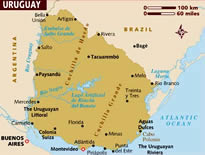| Home > Uruguay |
"We do not have any volunteer work projects in this country at this moment. For now, please check our projects in other countries but keep in mind we will update our offer soon!"
URUGUAY:
Country Profile of Uruguay
Uruguay has more tourists than any other South American country because of its 500km stretch of gorgeous beaches lining the Atlantic and the Rio de la Plata. Walking around the city is the best way to see Montevideo, the capital. 145 km from Montevideo is Punta del Este with two main beaches that offer water-skiing, surfing and yachting. Take a hydrofoil to Colonia Suiza and see the old Swiss Colony. If peace and quiet is what you need, stay at the seaside village of Aguas Dulces.
|
☻Capital: - Montevideo ☻Area: - 176,220 sq km (72,930 sq miles) ☻Independence: - from Spain Declared in 1825 |
☻Official languages: - Spanish (official), Portunol, Brazilero (Portuguese-Spanish mix on the Brazilian frontier) ☻Population: - 3.5 million (2009) |
Geography of Uruguay:
 Uruguay is a country in Southern South America, bordering the South Atlantic Ocean, between Argentina and Brazil. Uruguay is located in the Southern Hemisphere on the Atlantic seaboard of South America between 53 and 58 west longitude and 30 and 35 south latitude. It is bounded on the west by Argentina, on the north and northeast by Brazil, and on the southeast by the Atlantic Ocean. Uruguay is the smallest Spanish-speaking nation in South America with a land area of 173,620 km² and a water area of 2,600 km².
Uruguay is a country in Southern South America, bordering the South Atlantic Ocean, between Argentina and Brazil. Uruguay is located in the Southern Hemisphere on the Atlantic seaboard of South America between 53 and 58 west longitude and 30 and 35 south latitude. It is bounded on the west by Argentina, on the north and northeast by Brazil, and on the southeast by the Atlantic Ocean. Uruguay is the smallest Spanish-speaking nation in South America with a land area of 173,620 km² and a water area of 2,600 km².
Education in Uruguay:
 Uruguay was the first country in South America that had free and compulsory education. In 1877 the first Education Act was adopted so that all children had access to education. Elementary and secondary education is free and compulsory for all children until their fourteenth year. Higher education is not free. The result of this policy is that Uruguay has the lowest illiteracy rate in South America, approximately 4%.
Uruguay was the first country in South America that had free and compulsory education. In 1877 the first Education Act was adopted so that all children had access to education. Elementary and secondary education is free and compulsory for all children until their fourteenth year. Higher education is not free. The result of this policy is that Uruguay has the lowest illiteracy rate in South America, approximately 4%.Eighty percent of the workforce has at least primary school, forty percent had completed secondary education and 18.5% have a university education completed. For some years now, the importance of preschoolers is growing. At the moment 44% of children between three and six years go to kindergarten. Approximately 30% of the nat ional budget is invested in education.
There is a state university with such a highly respected medical school, an independent Roman Catholic university and a private technical university education, all located in Montevideo. Approximately 70% of all students at universities come from Montevideo.
Health in Uruguay:
The government pays a lot of attention to public health. In Uruguay the life expectancy is high (74 years in 2000); infant mortality is low (14 per 1,000 live births in 2000); and the ratios of doctors and beds to the population are very good. In 2000, 98% of the population had access to safe drinking water and 95% had adequate sanitation. At the end of 1999, the number of health care providers, with number per 1,000 people, was as follows: 12,486 physicians (4), 2,613 professional nurses (0.8), and 4,050 dentists (1.3).
The major causes of death are heart diseases, cancer, and digestive disorders. Degenerative diseases rank higher as a cause of death in Uruguay than in most other Latin American countries.
The major causes of death are heart diseases, cancer, and digestive disorders. Degenerative diseases rank higher as a cause of death in Uruguay than in most other Latin American countries.
Politics in Uruguay:
 Uruguay is a democratic republic with a president as representative. Elected for a 5-year term, the president is the head of state and chief of the government. If no presidential candidate receives an absolute majority of 51 percent of the vote, there is a runoff election in which only the top 2 candidates compete.
Uruguay is a democratic republic with a president as representative. Elected for a 5-year term, the president is the head of state and chief of the government. If no presidential candidate receives an absolute majority of 51 percent of the vote, there is a runoff election in which only the top 2 candidates compete.The Colorado and National parties have been locked in a power struggle, alternating throughout most of Uruguay's history. The elections of 2004, however, brought the Encuentro Progresista-Frente Amplio-Nueva Mayoría, a coalition of socialists, former Tupamaros, communists, social democrats, and Christian Democrats among others to power with majorities in both houses of parliament. A majority vote elected President Tabaré Vázquez.
In 2009, the majority was once again for the Broad Front, however, the amount of votes for the Broad Front didn't reach consensus, as the majority must be from more than half of the votes casted, so, it was necessary for a runoff to decide the next President. José Mujica and Luis Alberto Lacalle (supported by its former rivals, the Colorado Party) disputed the runoff, resulting in a win for the Broad Front candidate, thus being the second President of Uruguay from that party, being as well, the second consecutive.